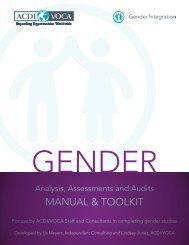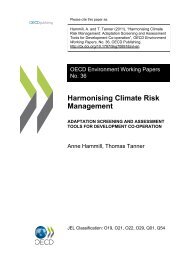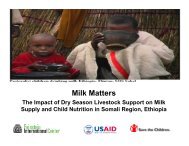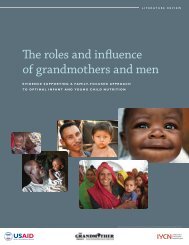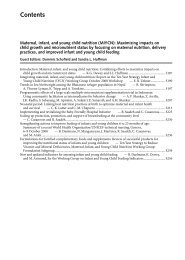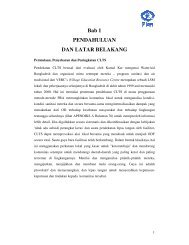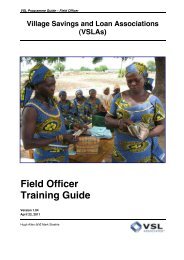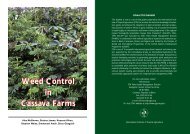Gender and climate change research in - FAO
Gender and climate change research in - FAO
Gender and climate change research in - FAO
You also want an ePaper? Increase the reach of your titles
YUMPU automatically turns print PDFs into web optimized ePapers that Google loves.
Box 2.9. Carbon markets<br />
There are many efforts underway to reduce greenhouse gas emissions <strong>and</strong> promote activities which help decrease,<br />
avoid or store carbon <strong>and</strong> other greenhouse gases. This has made carbon a valuable economic commodity. Carbon<br />
markets work <strong>in</strong> a similar way to f<strong>in</strong>ancial markets. The currency used on these markets is carbon credits.<br />
There are two types of carbon markets: regulatory compliance <strong>and</strong> voluntary markets. The compliance market is used by<br />
companies <strong>and</strong> governments that by law have to account for their GHG emissions. It is regulated by m<strong>and</strong>atory national,<br />
regional or <strong>in</strong>ternational carbon reduction regimes. On the voluntary market the trade of carbon credits is on a<br />
voluntarily basis. The size of the two markets differs considerably. In 2008, carbon credits worth US$119 billion were<br />
traded on the regulated market whereas on the voluntary market it was US$704 million’s worth of carbon credits.<br />
Regulatory market<br />
One of the important (Kyoto Protocol) mechanisms for the regulatory market is that of the Clean Development<br />
Mechanism (CDM). Develop<strong>in</strong>g countries are not obliged to reduce their GHG emissions under the Kyoto Protocol,<br />
whereas <strong>in</strong>dustrialised countries must fulfil specified targets. They can achieve these by reduc<strong>in</strong>g GHG emissions <strong>in</strong> their<br />
own country, by implement<strong>in</strong>g projects to reduce emissions <strong>in</strong> other countries or by trad<strong>in</strong>g. This means that countries<br />
that have satisfied their Kyoto obligations can sell their excess carbon credits to countries that are hav<strong>in</strong>g difficulties or<br />
f<strong>in</strong>d it too expensive to meet their targets. The idea of the CDM is that an <strong>in</strong>dustrialised country implements an emission<br />
reduction project <strong>in</strong> a develop<strong>in</strong>g country. This can be an afforestation, an energy efficiency or a renewable energy<br />
project.<br />
Examples of CDM projects<br />
Methane avoidance: energy, <strong>and</strong> fertilizer enterprise from dumped cattle waste <strong>in</strong> Pakistan<br />
Biogas: methane capture <strong>and</strong> combustion from poultry manure treatment at Lusakert Plant, Armenia<br />
Biomass production: electricity generation from mustard crop residues <strong>in</strong> India<br />
Reforestation programme: plant<strong>in</strong>g trees for timber, firewood <strong>and</strong> fodder production on degraded l<strong>and</strong> <strong>in</strong> Bagepalli,<br />
India<br />
Afforestation of grassl<strong>and</strong>: establishment <strong>and</strong> management of forest plantations <strong>in</strong> Tanzania<br />
The voluntary market<br />
The voluntary market has become very important for agriculture <strong>and</strong> forestry projects. Voluntary carbon credits are<br />
ma<strong>in</strong>ly purchased by the private sector. Corporate social responsibility <strong>and</strong> public relations are the most common<br />
motivations for buy<strong>in</strong>g carbon credits. Other reasons are considerations such as certification, reputation <strong>and</strong><br />
environmental <strong>and</strong> social benefits. There are a number of companies that offer clients the opportunity to neutralize<br />
their carbon emissions (e.g. some airl<strong>in</strong>e companies offer carbon neutral flights <strong>and</strong> global f<strong>in</strong>ancial services companies<br />
provide the equivalent amount of carbon credits). The private sector can either purchase carbon credits directly from<br />
projects, companies (e.g. Ecosecurities) or from carbon funds (e.g. The World Bank BioCarbon Fund).<br />
In general, the voluntary market is more <strong>in</strong>terest<strong>in</strong>g than the regulatory market for small-scale agriculture projects <strong>in</strong><br />
develop<strong>in</strong>g countries, because the CDM market has rather complex procedures <strong>and</strong> methodologies for project<br />
registration.<br />
(<strong>FAO</strong>, 2010a.)<br />
Key questions to be addressed are:<br />
<br />
<br />
<br />
<br />
<br />
<br />
What role do men <strong>and</strong> women play with regards to food security of family members<br />
Who <strong>in</strong> the household is vulnerable <strong>and</strong> how How is this vulnerability differentiated<br />
accord<strong>in</strong>g to gender, age <strong>and</strong> other social <strong>in</strong>dicators<br />
What do men <strong>and</strong> women perceive is at risk due to <strong>change</strong>s <strong>in</strong> <strong>climate</strong><br />
What do men <strong>and</strong> women currently do to deal with the risks<br />
Who decides what adaptation strategy to implement Who takes action <strong>and</strong> implements<br />
the strategy <strong>and</strong> is he/she <strong>in</strong>volved <strong>in</strong> the decision mak<strong>in</strong>g<br />
What are the implications of a given adaptation strategy on men’s <strong>and</strong> women’s use of<br />
time <strong>and</strong> labour <strong>and</strong> on their health<br />
Module 2: Concepts: gender <strong>and</strong> <strong>climate</strong> <strong>change</strong> issues <strong>in</strong> agriculture <strong>and</strong> food security 27



